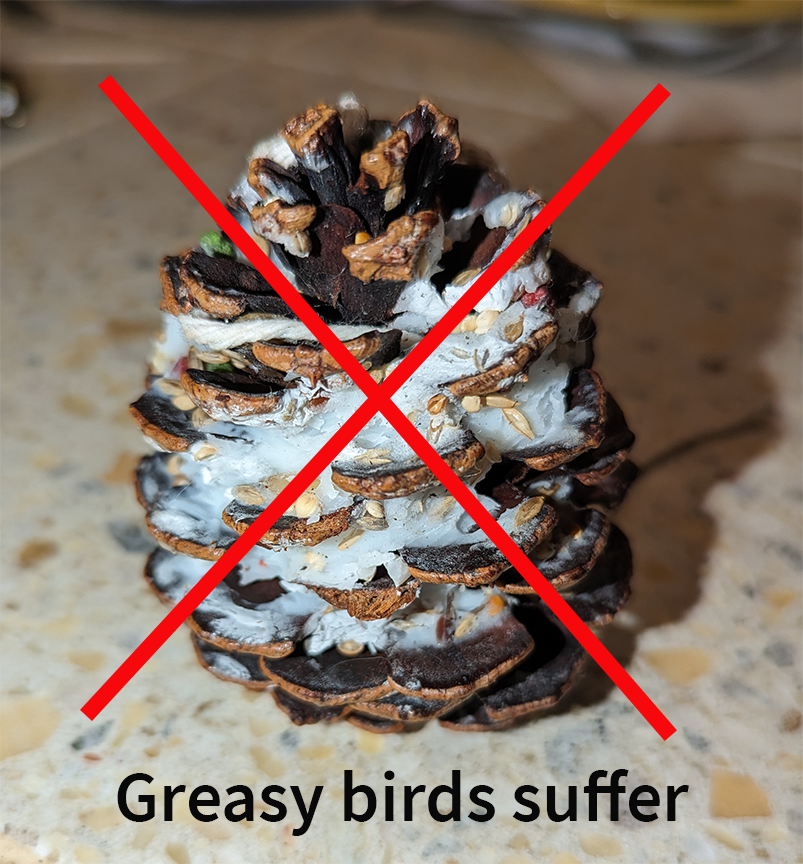|
Your birds will flock to this easy DIY bird-safe recipe for wreaths, ornaments, or balls. The birds can land directly on these treats without getting any greasy fats on their feet or into their feathers. It is a super easy recipe and being made with gelatin, it is high in protein. This project is fun for kids and not very messy! Please do not use those dangerous home-made suet pine cones that allow birds to get fats all over their feet and into their feathers. Dirty, greasy feathers cannot keep a bird warm, and in winter that is deadly. Ingredients:
For shapes use cookie cutters, the bottom of a Bundt pan, or just mold to the form you desire. Steps: 1. Mix the cold water and gelatin, stir, then wait one minute. 2. Stir in the boiling water until the gelatin dissolves. 3. Add the seed mix to the gelatin water and stir. Make sure all of the seed is coated. 4. Use a cookie cutter, a mold, the bottom of a Bundt pan, or form a shape. 5. Do not spray with oil since this is an oil/fat-free recipe. 6. To form your own shape: use wax paper, plate, or a pastry mat. Shape to whatever joyous or ghoulish image you'd like. Or, press the seed into cookie cutters or the bottom of the Bundt pan till compact, then put in the refrigerator overnight. 7. Create a hole for the ribbon by putting a chopstick or thick skewer into the seed. Hang:
Note: you do not need to add corn syrup or flour, neither of which are good for our birds. Making holiday crafts and decorations safe for our birds is pretty simple if we follow just a few general rules.
Follow our page to learn more about birds, how to care for those who share your yard, and get great ideas like the one here. For the Birds!
As a devoted songbird rehabilitation specialist at Native Bird Care Avian Rescue, I am deeply troubled by the mass mortality event playing out in Chicago. On just one night hundreds of birds hit the McCormick Place Conference Center in Chicago this week. This distressing event has reverberated throughout the conservation community, underscoring the urgent need to confront the issue of bird collisions in North America. With its expansive glass surfaces, prime location along Lake Michigan, and intense nighttime lighting, McCormick Place poses an extreme challenge for migratory birds. Chicago is considered the deadliest city for birds in North America. Thousands of birds will die in this mass death event. Sadly, Chicago is not an isolated case; the trend of the glass-dominated urban landscape is rising in Central Oregon as well as towns and cities across the country. Two overlapping natural events have contributed to this tragedy. A 'high-intensity bird migration' has substantially increased the number of birds passing through the area. These birds are encountering adverse weather conditions funneling them through the city, leaving them confronted with an urban landscape filled with glass walls instead of a natural environment. The Peril of Glass Glass buildings, like McCormick Place, may be architectural marvels, but they are perilous for birds. Bird collisions are a growing concern, with up to a billion birds succumbing to glass collisions each year in North America. Birds collide with glass due to the reflections they see; they see forest when it is a solid structure. McCormick Place's glass façade with large windows that reflect the surrounding environment are an extreme example, but Central Oregon has many bird-collision prone buildings. Birds perceive window reflections as extensions of the landscape and attempt to fly through them, resulting in fatal collisions. Many birds also migrate at night, and bright artificial lights can disorient them, confuse their magnetic compasses, and trap them in illuminated 'walls.' The September 11th Memorial in New York is an example of birds becoming trapped by light. Window collisions lead to severe injuries and often death, making window collisions a significant global threat to bird populations. The Toll on Migratory Birds Chicago is just one of thousands of critical stopover points for migratory birds navigating North America. Each year, over a billion birds journey from breeding areas in Canada and the United States to wintering grounds in Mexico and Central and South America. The species affected by this tragedy include warblers, sparrows, thrushes, and other neotropical migrants. But substantially more species than this are killed by windows. Birds are not just crucial for maintaining ecological balance; their loss disrupts our local ecosystems and poses a threat to the overall environment and human well-being. Solutions The recent bird deaths at Chicago's McCormick Place are a poignant reminder of the challenges migratory birds face today. Yet, solutions do exist. We can implement bird-friendly building designs. We can use after-construction window solutions so our homes and yards are bird-safe. We can reduce light pollution by using appropriate light fixtures and bulbs. And we can raise public awareness about birds and the challenges they face. Many songbird species are in decline; we can contribute to protecting our avian friends during their incredible journeys with simple steps. Let us work together to ensure that our actions preserve the beauty of our urban environment while safeguarding the vital role migratory birds play in our ecosystems and our lives. Please visit our Windows page for simple solutions. If you have questions or simply want ideas on how to keep your precious birds safe, contact us. Please email for ease of us replying. |
AboutNative Bird Care's is celebrating its 10th anniversary! Our main focus is song, shore, and waterbirds. We offer specialized care and facilities for these extraordinary birds.. Archives
July 2024
Categories
|





 RSS Feed
RSS Feed